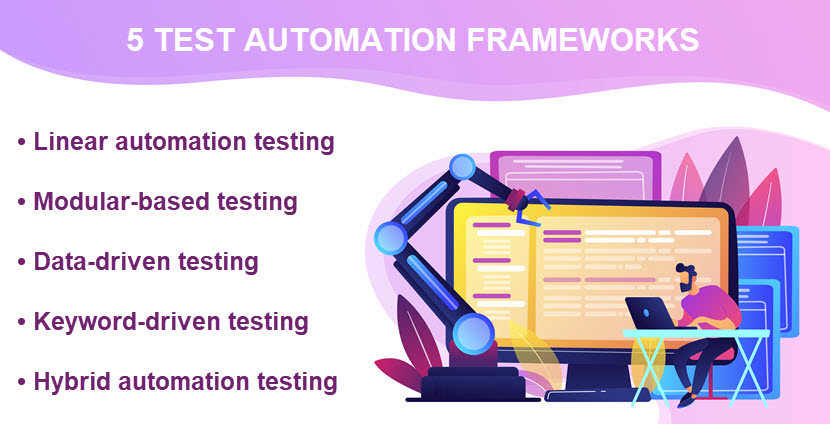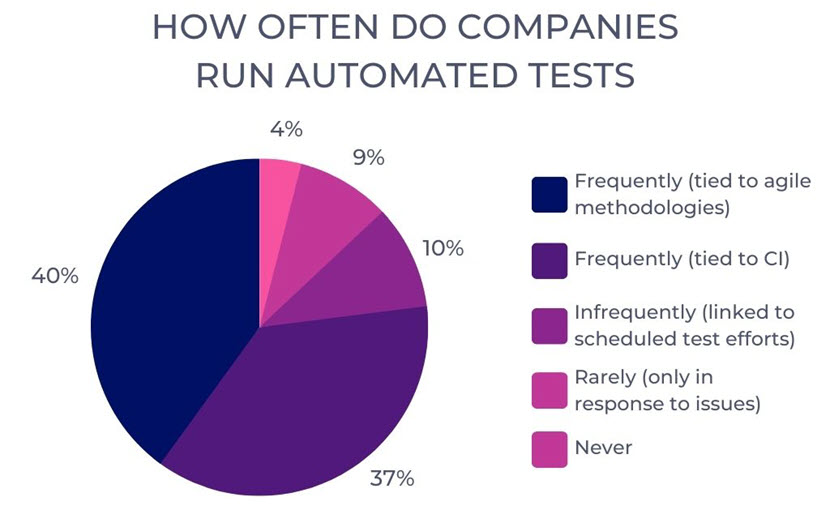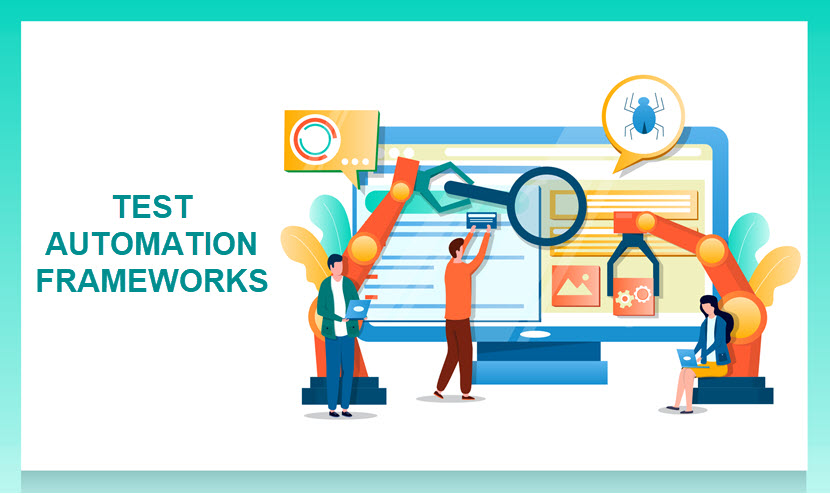Test automation frameworks provide valuable resources (libraries, guidelines, coding standards, etc.) Teams rely on frameworks to manage and perform automated software testing. Frameworks help developers and testers create highly effective testing strategies while enabling companies to boost the ROI of their QA departments.
This article takes you through five different test automation frameworks that make automated testing faster and more reliable. We provide high-level overviews of every framework, explain their main pros and cons, and offer advice on picking a framework that best fits your team’s priorities and IT needs.
Already familiar with the basics of automation frameworks and want to read about specific platforms? What Are Test Automation Frameworks
An automated testing framework is a collection of resources and guidelines that helps create, implement and execute automated tests. A framework makes it easier to create tests by providing teams with the following:
High-level testing strategies and guides.
- Coding standards (typically based on Java, C#, Python, or JavaScript).
- Code libraries for everyday testing tasks (interacting with the tested software, verifying expected outcomes, reporting test results, etc. ).
- Various testing tools, programs, and compilers.
- Mechanisms to manage test data (e.g., input values, expected results, test configurations, etc. ), execute scripts, and generate reports.
- Here’s an overview of the essential components you’ll find in most platforms that enable you to implement a test automation framework:
The AUT (Application-Under-Test).
- Test data.
- Driver scripts.
- Environment variables.
- General user library.
- Business user library.
- Recovery scenarios.
- An object repository.
- Test execution reports.
- Test automation frameworks provide various benefits that help develop and execute test scripts. Here are the most notable advantages of these frameworks:
Improved test speed and accuracy.
- Reduced cost of testing.
- A modular and scalable structure for script development.
- More productive teams.
- Lower risk of human errors during testing.
- Fewer bugs in production.
- More test code reusability.
- Reduced chance of test case duplication.
- The popularity of test automation frameworks grew alongside the rise of the DevOps culture. DevOps is a common principle that encourages testing as early as possible and as frequently as possible in the CI/CD pipeline. This task becomes significantly easier with a framework that helps organize, execute, and keep tests consistent.
Recent reports reveal that the global test automation market will reach
$28.8 billion by 2025 (up from $12.6 billion in 2020, which is a CAGR of 18.0%). The most significant factor driving this growth is the increased adoption of DevOps and agile testing practices.Types of Test Automation Frameworks
Below is a list of the five test automation frameworks companies use to make testing faster and more reliable. Read on to see which one makes the most sense for your testing requirements.
Linear Automation Test Framework

Linear automation is the most straightforward of all test automation frameworks. The team must:
Create a series of automated test scripts for each functionality that requires testing.
- Run test scripts individually when it’s time to test a feature.
- Testers write a single program in sequential steps without any modularity. For example, if you want to verify that the creation of a new Gmail account works correctly, you’d write a script with the following steps:
Open
- gmail.com.Click on “Create Account. “
- Enter details.
- Verify details.
- Create an account.
- Linear frameworks offer simplicity and clear test coverage for individual functionalities, which is why this is a go-to strategy for testing simple features.
Main pros of the linear automation framework:
Simple to understand since each test script focuses on a specific functionality.
- Scripts are simple and easy to write.
- Requires little upfront planning.
- Clear test coverage.
- Makes it easy to isolate and debug problems.
- Highly granular reporting and result tracking.
- Main cons of the linear automation framework:
Teams must create test scripts for each functionality separately.
- The linear nature limits the ability to handle complex test scenarios with conditional branching.
- Testers must embed all the data directly into the test code, so there’s no way to use the code for any other data set.
- Error-prone and challenging to maintain.
- Modular-Based Testing Framework
The modular-based testing framework breaks up the tested software into multiple isolated components (i.e., modules) with separate test scripts. Each module is focused on a particular functionality or feature. Then, testers combine individual scripts to build larger test cases hierarchically.
All testers that rely on modular-based frameworks build an abstraction layer to ensure changes in individual sections do not affect the overarching module. Another go-to strategy is to use design patterns such as Page Object Model (POM) or Model-View-Controller (MVC).
Main pros of the modular-based testing framework:
High level of modularization.
Modules are reusable, which promotes efficiency in testing and reduces duplication.
- Enables easy expansion of the test suite (either add new modules or combine existing ones).
- A change to one module reflects in all related test cases, which makes it easy to maintain and update tests.
- Modules compartmentalize test logic, which makes test code more manageable and structured.
- Main cons of the modular-based testing framework:
- Creating reusable modules is time-consuming.
Requires careful upfront planning for more complex apps.
- Interdependencies between components often cause problems.
- Test scripts must have hard-coded data.
- Most tests require a specific order of module execution, which often affects execution speed.
- Data-Driven Test Framework
- The data-driven test framework separates test data from script logic:

Test scripts contain the necessary steps and actions (scripts are parameterized, so they accept input values dynamically).
Test data contains the input values and expected results for each test case.
- That way, testers get to test the same feature or function multiple times with different data sets. The team instructs the scripts to populate and read data as needed. It is possible to reduce the number of scripts required for a test suite by reducing the number of data sets. There is also no need to hard-code data into the script itself (unlike the linear or modular-based testing framework).
- Main pros of the data-driven test framework:
Allows testers to reuse test scripts with different sets of data.
Makes test data easy to update and modify independently of test scripts.
Significantly reduces the number of scripts required to cover all the test scenarios.
- Easily accommodates a growing number of test cases (just add more data sets as the test suite expands).
- A broad test coverage that allows teams to test various scenarios and data combinations.
- Main cons of the data-driven test framework:
- Requires setting up and managing an external data source, plus infrastructure for accessing and managing test data.
- Testers must ensure a proper sync between test scripts and data sets.
Requires advanced knowledge of a test script programming language.
- You must ensure data integrity, accuracy, and completeness of test data to avoid false positives and false negatives.
- Identifying the root cause of failures in scripts is often challenging.
- Keyword-Driven Test Framework
- The keyword-driven test framework (also known as the
- table-driven
or
action-driven framework) separates human-readable instructions (i.e., keywords) from the underlying test automation logic. A tester creates a set of keywords that represent necessary test actions or operations, such as:Interacting with UI elements.Entering data.Clicking buttons.
- Verifying results.
- Navigating through different screens.
- The framework maps keywords to corresponding functions that carry out the actual actions on the app. You store keywords in a step-by-step fashion with an associated object, like in this example:
- Step number
- Description
Keyword
| Object | Step 1 | Click on the login button on the Home Page | clicklink |
|---|---|---|---|
| Login button | Step 2Enter username | inputdata | |
| Login username field | Step 3 | Enter password | inputdata |
| Login password field | Step 4 | Verify user login info | verifylogin |
| Submit button | With this framework, testers create scripts by simply specifying the sequence of keywords and associated test data. | Main pros of the keyword-driven test framework: | Human-readable keywords make test scripts easy to understand. |
Easy modification and adaptation of test scripts to different scenarios.
Testers get to reuse keywords across multiple test cases.
- Reduced duplication of code and improved maintainability of test suites.
- Excellent test coverage and scalability due to the ability to combine different keywords.
- Main cons of the keyword-driven test framework:
- Requires time and effort to define keywords.
- Testers must learn the framework’s unique conventions and structures.
Failing to define keywords clearly leads to confusion, errors, and testing limitations.
- The team must manage and regularly update the centralized repository of keywords, associated actions, and test data.
- Hybrid Test Automation Framework
- The hybrid approach combines elements of multiple test automation frameworks to create a custom strategy that suits your specific testing requirements. Here are a few common examples:
- Using keywords to define high-level test instructions and also relying on the data-driven framework to handle various test data sets.
Organizing test cases into modules while also sequentially creating and executing test scripts for each functionality.
Using the data-driven framework to handle various test data sets and linear automation framework’s sequential execution of scripts.
- The exact implementation of the hybrid model varies depending on the project and the organization’s needs.
- Main pros of the hybrid test automation framework:
- You get to select different elements from various frameworks to address specific testing needs and achieve optimal test coverage.
Highly flexible and provides the ability to handle complex and diverse testing requirements.
Reduces duplication of effort, improves efficiency, and enhances maintainability (when done right).
- Main cons of the hybrid test automation framework:
- Requires knowledge of different frameworks and expertise in integrating them effectively.
- Takes more time and effort to set up than when you use a single, off-the-shelf framework.
Changes or updates to any of the integrated frameworks impact the overall framework, so expect frequent tweaks to your testing strategy.
- Troubleshooting issues is more complex than when using a single framework.
- Concerned about how a test automation framework will impact your security? Consider implementing SecOps (a security-first approach to software development) to boost the overall safety of your entire pipeline.
- Which Automation Testing Framework Should You Use?
- Start by thoroughly evaluating your project and testing requirements. Consider these factors:
The application under test (types, technologies, architecture, platforms supported, features, complexity, etc.). ).
Required test coverage.
Long-term goals and upcoming plans for the app.
- Budget and licensing restrictions.
- Testing tools and practices already in place.
- Once you thoroughly understand your project, determine what framework features you require. A few common capabilities and traits companies typically look for are:
- Test code reusability.
- Scalability.
The ease of test script maintenance.
- Compatibility with existing CI/CD tools and processes.
- Community support and documentation.
- No cascade of failures (i.e., one test failing does not stop the entire testing process).
- Support for plugins or extensions.
- Next, assess the team’s expertise and preference by gathering input from all relevant stakeholders (developers, testers, and project managers). The familiarity of the team with frameworks, languages and automation tools will help to ensure a smoother adoption process. Choosing a framework your team has prior experience in ensures a smoother adoption process and fewer issues during testing.
- Here are a few general pointers to keep in mind when choosing a framework:
- Simpler projects and less experienced teams do well with linear and modular-based testing.
Apps with intricate workflows and interactions are typically an excellent fit with data-driven testing.
Consider the keyword-based framework if your testing process involves a few non-technical stakeholders.
- Think twice before deciding to invest time and money into creating a hybrid framework.
- If your apps undergo frequent updates, choose a framework that provides robust mechanisms for maintaining test scripts.
- Always conduct one or more
- proof of concept (POC) projects
- before making the final decision. Consider a few smaller test scenarios and compare the frameworks to see if they meet your needs. Only go “all-in” on a framework if it performs well during these pilot tests.
Make Full Use of Test AutomationChoosing the right test automation framework limits the number of bugs in production, increases overall test accuracy, and turns apps into more reliable products. Automated tests also increase the cost-effectiveness and reliability of QA processes. Select a framework to fit your SDLC, then start using test automation.
